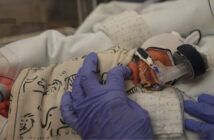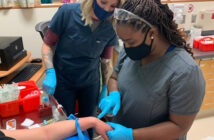Getting distracted while you’re driving can be catastrophic: from 2009–11 in Oregon 41 people died in distracted driving crashes. Even if you were buckled up properly, obeying the speed limit and driving sober, a split-second distraction could cost a life.
“Distracted driving is a behavior that’s dangerous to drivers, passengers and even people walking or biking,” said Troy E. Costales, Oregon Department of Transportation Safety Division administrator, who noted that in addition to the distracted driving deaths, there were five pedestrians or bicyclists who were killed in crashes while they were distracted. “When drivers divert their attention from the task of driving to focus on some other activity, they’ve just increased their chances of getting in a crash. And the same is true for bicyclists and pedestrians who are distracted. It’s worth our time to pay attention when we’re out using the transportation system.”
Across the U.S. one of every 10 fatalities on the nation’s roadways can be attributed to a distracted driver. While most any activity can distract a driver, one of the more common behaviors is using a cell phone. It’s illegal to use a handheld mobile communications device while driving in Oregon, for almost everyone, but people still do, and it’s dangerous. According to the U.S. Department of Transportation, sending or receiving a text takes a driver’s eyes from the road for an average of 4.6 seconds. Traveling 55 mph, 4.6 seconds of texting is like driving the length of a football field full of people while blindfolded.
A dangerous distraction, though, can occur anytime a driver voluntarily diverts attention to something not related to driving that requires the use of the driver’s eyes, ears or hands. For bicyclists, it means not watching or listening for potential interference from vehicles, trains or other traffic. For pedestrians, having earphones in or being distracted by texting can result in dangerous behavior, such as crossing a busy street at a location other than a crosswalk. All of these situations have one thing in common: not paying attention to the task at hand.
Driver distraction can be especially deadly. According to the Governor’s Highway Safety Association, there are four types of driver distraction:
• Visual: looking at something other than the road
• Auditory: hearing something not related to driving
• Manual: moving your hands from the wheel
• Cognitive: thinking about something other than the complex driving task at hand
Examples of distracted driving include using a cell phone, eating, grooming or reading. Before engaging in a distracting behavior – whether you are behind the wheel, on a bike or walking in a high traffic area – consider the potential consequences, and then get to a safe place before you take any action that takes you away from being focused.
Here are a few other tips to avoid distracted driving, from the AAA Foundation and ODOT:
1. Plan ahead. Check TripCheck.com or call 511 before you head out. Look at your route and plan your options for stopping.
2. Stow electronic devices. You can retrieve them when you pull over.
3. Buckle up. Make sure your passengers and pets are properly secured.
4. Eat and be hydrated. Get a meal in before you get behind the wheel so you won’t be tempted to root around for food or drink while driving.
5. Stow loose objects. The fewer things that can roll around and distract you, the better.
6. Bicyclists and pedestrians: keep an eye and an ear out for traffic.
Most importantly, “get your brain in the game.” Scan the road, use your mirrors often and stay alert. To learn more about the impacts of distracted driving and what you can do to prevent it, visit www.distraction.gov.




